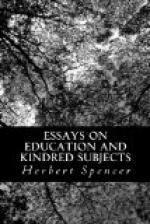EDUCATION: INTELLECTUAL, MORAL, AND PHYSICAL
The four chapters of which this work consists, originally appeared as four Review-articles: the first in the Westminster Review for July 1859; the second in the North British Review for May 1854; and the remaining two in the British Quarterly Review for April 1858 and for April 1859. Severally treating different divisions of the subject, but together forming a tolerably complete whole, I originally wrote them with a view to their republication in a united form; and they would some time since have thus been issued, had not a legal difficulty stood in the way. This difficulty being now removed, I hasten to fulfil the intention with which they were written.
That in their first shape these chapters were severally independent, is the reason to be assigned for some slight repetitions which occur in them: one leading idea, more especially, reappearing twice. As, however, this idea is on each occasion presented under a new form, and as it can scarcely be too much enforced, I have not thought well to omit any of the passages embodying it.
Some additions of importance will be found in the chapter on Intellectual Education; and in the one on Physical Education there are a few minor alterations. But the chief changes which have been made, are changes of expression: all of the essays having undergone a careful verbal revision.
H.S.
LONDON, May 1861
SPENCER’S ESSAYS
PART I—ON EDUCATION
WHAT KNOWLEDGE IS OF MOST WORTH?
It has been truly remarked that, in order of time, decoration precedes dress. Among people who submit to great physical suffering that they may have themselves handsomely tattooed, extremes of temperature are borne with but little attempt at mitigation. Humboldt tells us that an Orinoco Indian, though quite regardless of bodily comfort, will yet labour for a fortnight to purchase pigment wherewith to make himself admired; and that the same woman who would not hesitate to leave her hut without a fragment of clothing on, would not dare to commit such a breach of decorum as to go out unpainted. Voyagers find that coloured beads and trinkets are much more prized by wild tribes than are calicoes or broadcloths. And the anecdotes we have of the ways in which, when shirts and coats are given, savages turn them to some ludicrous display, show how completely the idea of ornament predominates over that of use. Nay, there are still more extreme illustrations: witness the fact narrated by Capt. Speke of his African attendants, who strutted about in their goat-skin mantles when the weather was fine, but when it was wet, took them off, folded them up, and went about naked, shivering in the rain! Indeed, the facts of aboriginal life seem to indicate that dress is developed out of decorations. And when we remember that even among ourselves most think more about the fineness of the fabric than its warmth, and more about the cut than the convenience—when we see that the function is still in great measure subordinated to the appearance—we have further reason for inferring such an origin.




